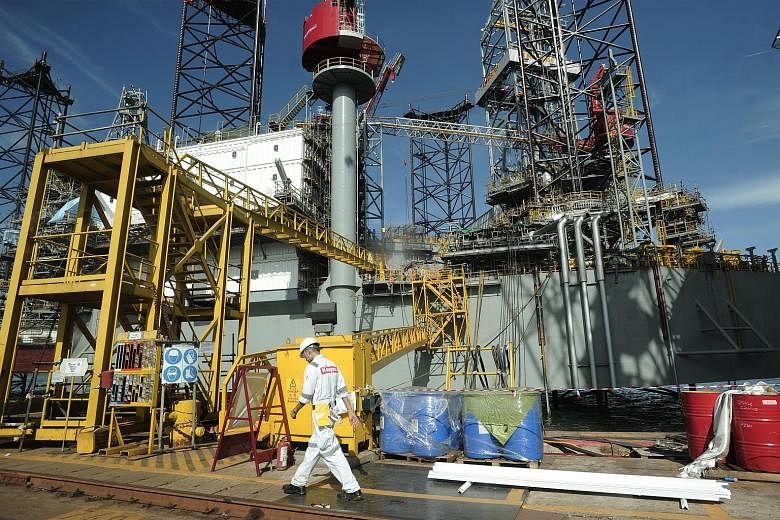The return of the bears to the oil market in recent weeks has undermined any semblance of a recovery for local offshore and marine players.
Brent crude, the global benchmark, stood at US$47 a barrel last Friday - an improvement over the US$45 levels seen last month, but not any better than a year ago.
KGI Securities Singapore analyst Joel Ng said this means the recovery for the local offshore and marine sector is now delayed - possibly by a few quarters or even years.
"Investments are currently flowing to United States shale production, given its lower payback periods compared with offshore developments," said Mr Ng.
"The recovery in the offshore and marine sector is dependent on how well it can bring down break-even costs to a level similar to other sources of oil, specifically US shale production."
And while analysts agreed that the crisis is at its bottom now, they said it will be a while more before firms see demand pick up in a significant way. More bankruptcies and debt defaults - such as those that have hit Swiber Holdings and Ezra Holdings - could take place in the meantime.
OIL PRICE RISE BOUND BY INERTIA
Research firm BMI Research noted recently that oil prices have proven weaker than expected this year.
A rebound in Opec crude exports in May has renewed fears that the massive supply glut is not going away, undoing earlier gains that saw prices keep steady at above levels of US$50 a barrel since the start of this year.
In other words, nearly three years on, after oil prices crashed, crude is still at levels lower than half the highs of US$115 seen in June 2014.
BMI has revised down its forecast for Brent prices for the period 2017 to 2021, and expects them to average US$54 per barrel this year, down from US$57 previously, given that Opec cuts have been slower to take effect than it had anticipated and "demand has disappointed".
But it added that oil prices will likely recover in the second half of this year, driven by Opec production cuts, a slowdown in global supply growth and seasonally firming demand. Said BMI: "Large-volume supply additions will keep price growth flat year on year in 2018, before a thinning projects pipeline and rising emerging markets demand push the market into deficit from 2019."
CRISIS BOTTOMING OUT - BUT FOR HOW LONG?
The good news is that oil majors and exploration companies worldwide are starting to raise their capital expenditures and roll out plans to revive stalled projects.
Closer to home, a number of companies seem to be seeing sentiment take a slight turn for the better as well. Big boys Keppel Offshore and Marine (Keppel O&M) and Sembcorp Marine - also the world's largest rig builders - were unable to respond to queries from The Straits Times because of a blackout period ahead of their earnings announcement later this month, but both have posted signs of improving prospects.
Keppel O&M, for example, sealed the deal last month with Borr Drilling to take over the construction contracts of the five jack-up rigs initially ordered by Transocean, in a move that will boost its cash flow and minimise risks. It also added another $85 million worth of new contracts to its order book, which stood at around $3.5 billion in the first quarter.
SembMarine swung back into the black last year after suffering a net loss of $289.7 million in 2015, and further booked a net profit of $40 million for the first three months this year.
Mr Ang Ding Li, IHS Markit's Asia-Pacific head of upstream cost research, said that the downturn in the offshore and marine industry is already at its bottom.
However, the question remains as to how long this bottom will last before recovery comes, he added.
Mr Ang noted that the difference today, compared with a year ago, is that industry stakeholders are more confident that oil prices have achieved stability. This, in turn, has encouraged capital investments amid significantly lower costs.
"As long as stakeholders believe confidently that US$50 to US$60 is a stable state for oil prices in the medium term, projects will move forward," he said.
The recovery here - when it does come - will be led by the shipyards, namely Keppel O&M and SembMarine. "But don't expect boom time," Mr Ang stressed. "Rig building is in a vegetative state, if not dead, for the next five to 10 years. And we will see serious competition for floating production storage and offloading conversions from China."
The offshore and marine industry as a whole, he added, will continue to be plagued by financial difficulties. "The vessel market is still severely oversupplied and it looks like we need more bankruptcies and scrappage to achieve some kind of a balance," he said.
MORE PAIN STILL TO COME
The Government has backed around $380 million of loans extended by banks to the marine and offshore engineering industry, under two schemes announced last November, in a bid to help stabilise the industry financially.
The move follows two high-profile insolvencies - Swiber last year and Ezra in March this year.
The funding has given some firms a vital leg-up, but it is unlikely to do more than to provide support for the short term, given the magnitude of the financial burdens that most companies face in a capital-intensive industry such as this.
Indeed, KGI's Mr Ng believes that more bankruptcies are on the horizon, particularly among the highly leveraged small to mid-sized oil and gas companies with weak prospects in the next two to three years.
"There are just too many assets like drilling rigs and offshore support vessels in the market," he said, noting utilisation rates for such assets slumped to 50 per cent to 60 per cent in May, from 90 per cent to 100 per cent before the downturn.
"Many of these assets, which are owned by local companies, will not be able to find work in the future. Hence, the book values on their balance sheets do not reflect the actual market values," Mr Ng noted.
"What this means is that many of them have negative equity (total liabilities more than total assets) if they were to mark to market their assets," he said, although stopping short of naming the firms.
OCBC Bank credit analyst Nick Wong said that for many companies, debt servicing remains a major concern as the ability to generate operating cash flow remains weak amid still challenging conditions.
The Singapore bond market, already rocked by a spate of defaults from the sector last year, continues to look vulnerable as bond maturities loom ahead.
Malaysian shipbuilder Nam Cheong has three tranches of outstanding bonds - $90 million due on Aug 28, $75 million due in July next year and $200 million due in August 2019 - all of which are trading at distressed levels, while offshore marine support services firm Pacific Radiance has $100 million of 4.3 per cent bonds maturing on Aug 29 next year.
Nam Cheong financial controller Chong Chung Fen told The Straits Times that discussions with the group's creditors and key stakeholders are ongoing. The loss-making company appointed a financial adviser in March to carry out a review of its financial position and to formulate a debt-restructuring plan.
However, it was slapped with a court summons last month by OCBC for US$10 million (S$13.8 million) lent to a Nam Cheong unit.
Separately, a Pacific Radiance spokesman said the group has a "good and open working relationship with its bankers", and that it has been working to strengthen its financials and enhance cash flows since the downturn.
Even issuers that have undergone out-of-court debt restructuring are still at risk of outright default, noted OCBC's Mr Wong, pointing to Marco Polo Marine, which in May filed to enter a scheme of arrangement and for a moratorium on its debt. "The difficult environment trumps all and there looks to be still pain to come," he said.



